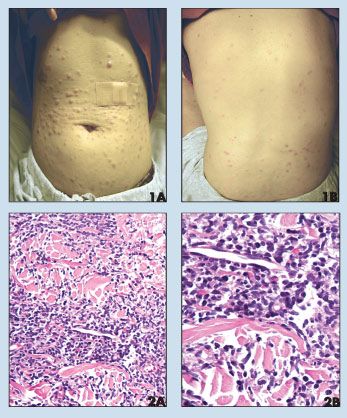Diagnostic Dilemma: Skin Disease
Pruritic papulo-nodular eruption
Pruritic papulo-nodular eruption
A 35-year-old woman was admitted to the hospital in January 2006, presenting with generalized pruritic cutaneous papules and nodules. Her current medications included acyclovir and pantoprazole.

Physical examination revealed a well-appearing young woman in no acute distress. She was afebrile with normal vital signs. The exam showed numerous mild erythematous papules and nodules distributed on the trunk and extremities (see Figures 1A and 1B). There was no lymphadenopathy. The liver and spleen were not palpable. There was no sternal tenderness. The remainder of the physical examination was unremarkable.
Laboratory evaluation showed white blood cell count of 9.3 109/L and hemoglobin of 10.1 g/dL. Comprehensive chemistry panel was normal except for mildly elevated AST 69 U/L and LDH 196 U/L. A punch biopsy was performed (see Figures 2A and 2B).
1) The photographs reveal findings noted at the time of a diagnostic and therapeutic procedure. What is your diagnosis?
a) Drug-induced pseudolymphoma
c) Aleukemic myeloid leukemia syndrome cutis
b) Drug eruption
d) Lymphomatoid papulosis
1. The correct answer is (c), aleukemic myeloid leukemia cutis. A biopsy specimen taken from the skin showed infiltrates of monotonous uniform cells with round nuclei, prominent nucleoli, and granular cytoplasm throughout the dermis (see Figures 2A and 2B on previous page).
Immunophenotyping by immunohistochemistry identified tumor cells of the myeloid lineage with monocytic differentiation (data not shown).
The patient's past medical history was significant for a questionable cutaneous hematodermic neoplasm that spontaneously resolved preceding the onset of acute myelogenous leukemia (AML, FAB subtype M5b, trisomy 8, SLT positive) diagnosed in November 2005. She was initiated on a clinical trial with daunorubicin and cytosine arabinoside (cytarabine).
Her course was complicated by severe refractory thrombocytopenia, but the patient eventually recovered and was discharged in November 2005 in stable condition with a post-induction bone marrow biopsy that was negative for leukemic cells. She was seen on a follow-up in December 2005 with a new onset of a skin rash.
Aleukemic leukemia cutis is a rare condition in which leukemic cells invade the skin before they appear in peripheral blood or bone marrow specimens.[1,2] In our case, the patient relapsed solely to the skin without evidence of lymph node or bone marrow involvement.
It is recognized that AML with trisomy 8 is more commonly associated with cutaneous infiltration.[3] It is also well known that aleukemic myeloid leukemia cutis is more often associated with AML with monocytic differentiation (FAB M4/M5).[1,2]
Primary cutaneous infiltration is frequently misdiagnosed as atypical lymphoma. The relationship of hematodermic CD4+CD56+ malignancies, recently reclassified as a tumor of plasmacytoid dendritic cell lineage, with myeloid leukemias has been described.[4] Interestingly, our patient had a questionable history of a cutaneous hematodermic neoplasm according to an outside biopsy prior to the appearance of leukemic cells in peripheral blood or bone marrow samples, but CD56 was not expressed.
Treatment for aleukemic leukemia cutis has been mostly unsuccessful and was found to be associated with a very poor outcome.[1] This patient underwent re-induction therapy with high-dose cytosine arabinoside (HIDAC). However, the skin infiltrates never regressed completely, and she was referred in February 2006 for an HLA identical sibling donor allogeneic hematopoietic stem cell transplant with total body irradiation and an etoposide conditioning regimen. The patient remains in remission 18 months after completion of treatment.
References:
1. Byrd JC, Edenfield WJ, Shields DJ, et al: Extramedullary myeloid cell tumors in acute nonlymphocytic leukemia: A clinical review. J Clin Oncol 13:1800-1816, 1995.
2. Ohno S, Yokoo T, Ohta M, et al: Aleukemic leukemia cutis. J Am Acad Dermatol 22:374-377, 1990.
3. Sen F, Zhang XX, Prieto VG, et al: Increased incidence of trisomy 8 in acute myeloid leukemia with skin infiltration (leukemia cutis). Diagn Mol Pathol 9:190-194, 2000.
4. Feuillard J, Jacob MC, Valensi F, et al: Clinical and biologic features of CD4+CD56+ malignancies. Blood 99:1556-1563, 2002.